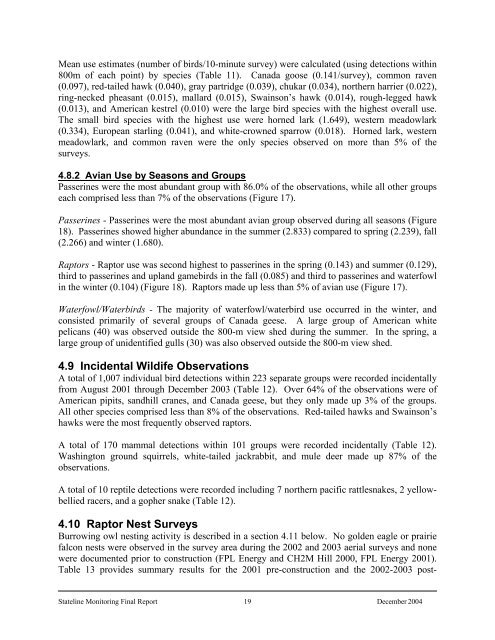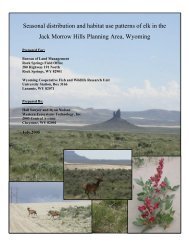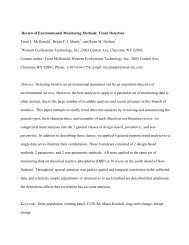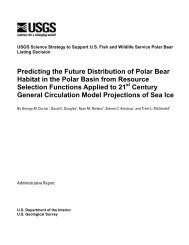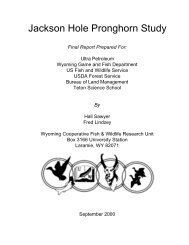Stateline Wind Project Wildlife Monitoring Final Report - WEST, Inc.
Stateline Wind Project Wildlife Monitoring Final Report - WEST, Inc.
Stateline Wind Project Wildlife Monitoring Final Report - WEST, Inc.
Create successful ePaper yourself
Turn your PDF publications into a flip-book with our unique Google optimized e-Paper software.
Mean use estimates (number of birds/10-minute survey) were calculated (using detections within<br />
800m of each point) by species (Table 11). Canada goose (0.141/survey), common raven<br />
(0.097), red-tailed hawk (0.040), gray partridge (0.039), chukar (0.034), northern harrier (0.022),<br />
ring-necked pheasant (0.015), mallard (0.015), Swainson’s hawk (0.014), rough-legged hawk<br />
(0.013), and American kestrel (0.010) were the large bird species with the highest overall use.<br />
The small bird species with the highest use were horned lark (1.649), western meadowlark<br />
(0.334), European starling (0.041), and white-crowned sparrow (0.018). Horned lark, western<br />
meadowlark, and common raven were the only species observed on more than 5% of the<br />
surveys.<br />
4.8.2 Avian Use by Seasons and Groups<br />
Passerines were the most abundant group with 86.0% of the observations, while all other groups<br />
each comprised less than 7% of the observations (Figure 17).<br />
Passerines - Passerines were the most abundant avian group observed during all seasons (Figure<br />
18). Passerines showed higher abundance in the summer (2.833) compared to spring (2.239), fall<br />
(2.266) and winter (1.680).<br />
Raptors - Raptor use was second highest to passerines in the spring (0.143) and summer (0.129),<br />
third to passerines and upland gamebirds in the fall (0.085) and third to passerines and waterfowl<br />
in the winter (0.104) (Figure 18). Raptors made up less than 5% of avian use (Figure 17).<br />
Waterfowl/Waterbirds - The majority of waterfowl/waterbird use occurred in the winter, and<br />
consisted primarily of several groups of Canada geese. A large group of American white<br />
pelicans (40) was observed outside the 800-m view shed during the summer. In the spring, a<br />
large group of unidentified gulls (30) was also observed outside the 800-m view shed.<br />
4.9 <strong>Inc</strong>idental Wildife Observations<br />
A total of 1,007 individual bird detections within 223 separate groups were recorded incidentally<br />
from August 2001 through December 2003 (Table 12). Over 64% of the observations were of<br />
American pipits, sandhill cranes, and Canada geese, but they only made up 3% of the groups.<br />
All other species comprised less than 8% of the observations. Red-tailed hawks and Swainson’s<br />
hawks were the most frequently observed raptors.<br />
A total of 170 mammal detections within 101 groups were recorded incidentally (Table 12).<br />
Washington ground squirrels, white-tailed jackrabbit, and mule deer made up 87% of the<br />
observations.<br />
A total of 10 reptile detections were recorded including 7 northern pacific rattlesnakes, 2 yellowbellied<br />
racers, and a gopher snake (Table 12).<br />
4.10 Raptor Nest Surveys<br />
Burrowing owl nesting activity is described in a section 4.11 below. No golden eagle or prairie<br />
falcon nests were observed in the survey area during the 2002 and 2003 aerial surveys and none<br />
were documented prior to construction (FPL Energy and CH2M Hill 2000, FPL Energy 2001).<br />
Table 13 provides summary results for the 2001 pre-construction and the 2002-2003 post-<br />
<strong>Stateline</strong> <strong>Monitoring</strong> <strong>Final</strong> <strong>Report</strong> 19<br />
December 2004


